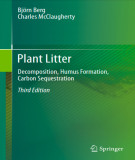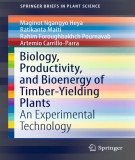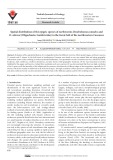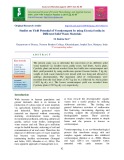
Plant litter
-
Ebook "Plant litter: Decomposition, humus formation, carbon sequestration (Third edition)" gives some new aspects on decomposition that to some of us may be controversial. Thus, the fact that we emphasize the dominant role of microorganisms in the process may be disturbing to many readers, as well as the strong emphasis we give to the fact that humus layers actually do grow over millennia and that at a considerable rate, and thus really sequester e.g. C and N. This book is based primarily on data and conclusions made from field studies.
 324p
324p  manmanthanhla0201
manmanthanhla0201
 26-02-2024
26-02-2024
 1
1
 1
1
 Download
Download
-
Ebook "Plant-plant allelopathic interactions II: Laboratory bioassays for water-soluble compounds with an emphasis on phenolic acids" presents detailed descriptions and analyses of the underlying features, issues and suppositions associated with seed and seedling laboratory bioassays presented in a previous volume. It is, however, broader in scope and substance in that the information provided is relevant to all water-soluble compounds released to soil by putative allelopathic living plants and their litter and residues.
 337p
337p  nhanphanguyet
nhanphanguyet
 28-01-2024
28-01-2024
 3
3
 2
2
 Download
Download
-
Ebook "Plant litter: Decomposition, humus formation, carbon sequestration" gives basic facts about litter decomposition studies, which are of guidance for scientists who start studies. Since the publication of the third edition, there has been quite a development not only in the field of litter decomposition but also in supporting branches of science, which are important for fruitful work on and understanding of decomposition of plant litter and sequestration of carbon.
 341p
341p  tachieuhoa
tachieuhoa
 28-01-2024
28-01-2024
 5
5
 2
2
 Download
Download
-
Ebook "Biology, productivity and bioenergy of timber-yielding plants: An experimental technology" deals with the characterization of the vegetation, morphology, phenological development, biomass production (leaf, litter, wood), and bioenergy of some timber-yielding species of Northeast Mexico, which will serve as a guide to study timber-yielding plants in the native vegetation of Tamaulipan thornscrub and experimental plantations.
 147p
147p  lucchinguyen
lucchinguyen
 28-12-2023
28-12-2023
 11
11
 2
2
 Download
Download
-
Evaluation of the spatial distribution of 2 ecologically similar, but different, in terms of their spatial ranges, earthworm species, D. octaedra and D. attemsi, in the belt forests of northwestern Caucasus were based on our own natural data and using geographic information system (GIS) modeling of modern potential distributions. The quantitative records of earthworms were collected in beech, deciduous, dark coniferous, coniferous-deciduous, and pine forests (1028 geographic locations).
 10p
10p  dolomite36
dolomite36
 30-12-2021
30-12-2021
 6
6
 0
0
 Download
Download
-
The objectives of the study were to determine the effect of three compost types i.e. Accra compost and recycling plant (ACARP) compost; decentralised compost (DeCo) and composted deep litter chicken manure (CDLCM) on heavy metals concentrations in roselle (Hibiscus sabdariffa L.) and jute mallow (Corchorus olitorius L.) and the health risk of these vegetables to adults and children.
 6p
6p  schindler
schindler
 30-12-2021
30-12-2021
 7
7
 0
0
 Download
Download
-
The present study was to determine the conversion of six different solid waste materials viz. kitchen waste, paddy straw, leaf litters, Azolla plant, Cyathula plant and mixed sawdust from local mills into vermicompost and their yield potential by using earthworm species Eisenia foetida. 5 kg dry weight of each waste material were mixed with cow dung and allowed to undergo decomposition. The maximum yield of vermicompost were recorded from the leaf litters (3.937 kg dry wt.) followed by Azolla plant (3.655 kg dry wt.). The lowest vermicompost yield was recorded from Cyathula plant (2.
 4p
4p  nguaconbaynhay6
nguaconbaynhay6
 24-06-2020
24-06-2020
 15
15
 0
0
 Download
Download
-
The study was carried out at school of forestry and environment nursery, Allahabad, Uttar Pradesh. An eight year old plantation of clone of G-48 of Poplar (Populus deltoids) was selected. The leaf litter fall we found that the decomposition of poplar leaf litter is very slow; this has detrimental physical effect on wheat intercrop. Plant height, numbers of leaves/ plant, fresh wt. of root (g) dry wt. of root (g), numbers of tiller/plants, fresh wt. of shoot (g), dry wt.
 5p
5p  trinhthamhodang1213
trinhthamhodang1213
 29-05-2020
29-05-2020
 10
10
 0
0
 Download
Download
-
The eastern Mediterranean region is one of the main areas of the Mediterranean vegetation containing Calabrian cluster pine (Pinus brutia Ten., Pinaceae) forests and terebinth (Pistacia terebinthus L., Anacardiaceae) communities. This study was carried out with the leaves, shoots, leaf litters, and soils of Calabrian cluster pine and terebinth growing on both marl and conglomerate substrata in the eastern Mediterranean region (Turkey) to determine average C, N, P and K contents, and the amounts of humic and fulvic acid in these plant soils.
 7p
7p  vibasque27
vibasque27
 29-03-2019
29-03-2019
 22
22
 1
1
 Download
Download
-
Plant litter decomposition is controlled by both biotic and abiotic factors. It has been widely hypothesized that litter quality and climatic and soil conditions regulate decomposition. The present study examined the decomposition of native forest tree litter on 2 aspects (the north and the south) and at 3 altitudes (top, middle, and bottom) on each aspect in Artvin province to determine the influence of litter quality, microclimate, and soil characteristics on the rate of decomposition.
 13p
13p  masterbarista
masterbarista
 15-01-2019
15-01-2019
 24
24
 1
1
 Download
Download
-
The treaty, called the Stockholm Convention on Persistent Organic Pollutants, is a major achievement. It starts by immediately targeting 12 particularly toxic POPs for reduc- tion and eventual elimination. More importantly, it sets up a system for tackling additional chemicals identified as unacceptably hazardous. It recognizes that a special effort may sometimes be needed to phase out certain chemicals for certain uses and seeks to ensure that this effort is made. It also channels resources into cleaning up the existing stockpiles and dumps of POPs that litter the world’s landscape.
 24p
24p  cao_can
cao_can
 02-01-2013
02-01-2013
 58
58
 4
4
 Download
Download
-
Forests cover about 30 percent of total land area, but they store about 50 percent of the Earth’s terrestrial carbon (1,150 GtC) in plant biomass, litter and debris, or in the soil. About 20 percent of total GHG emissions are caused by deforestation and land use changes but in tropical regions emissions attributable to land clearance are much higher, up to 40 percent of national totals. Reducing deforestation and degradation (REDD) is the forest mitigation option with the largest potential for maintaining carbon stocks in standing forests over the short term.
 41p
41p  yeurauxanh88
yeurauxanh88
 01-10-2012
01-10-2012
 56
56
 3
3
 Download
Download
CHỦ ĐỀ BẠN MUỐN TÌM
























